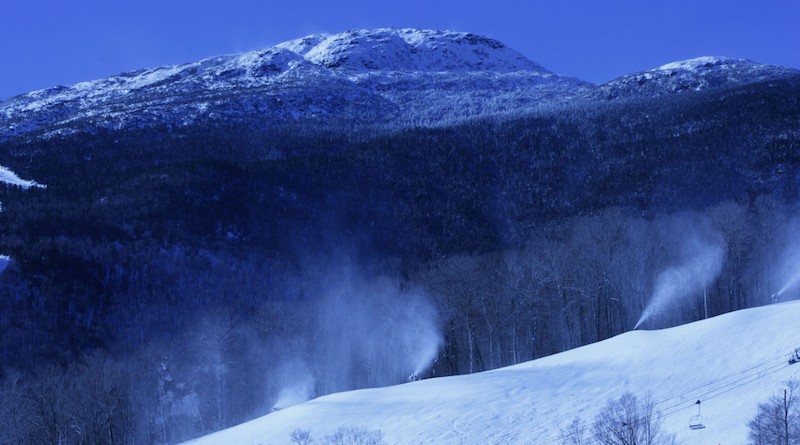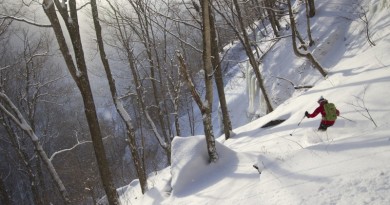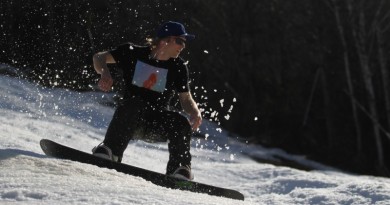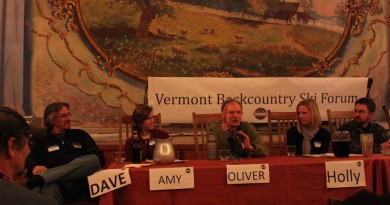Snowmaking: The Art Of Damage Control
Vermont’s high percentage of ski trails that are covered by snowmaking is critical for keeping skiing going when Mother Nature can’t.
By Evan Johnson, Angelo Lynn
After early January’s rain, super-freeze and thaw, here’s the shocker: The skiing is good out there. It’s not epic, but it’s surprisingly good.
How can that be with heavy rains and temps reaching the low 50s earlier this month? Snowmaking.
The state’s ski resorts have been pouring money into better and more efficient systems for the past decade and it shows. Give Vermont’s resorts just 24-hours of cold weather and they can turn what used to be a disaster (in the year’s before snowmaking was this powerful) into a skiing surface that makes heroes out of rookies.
Fact: Vermont ski areas have 80-plus percent of their trails covered with snowmaking. That’s the most of any state in the union, by far, and 20 percent more than New Hampshire and far more than any ski area out West.
Fact: Even after a rain event, followed by sub-zero temperatures, the snowmaking capacity at most of Vermont’s resorts combined with an army of grooming machines routinely turns hard-pack surfaces into an groomed surface that any skier can enjoy in a single 24-hour period.
That snowmaking capacity and expert grooming, called miracle-making by some, is at the heart of what makes Vermont skiing so dependable.
RECORD SPENDING
Stowe Resort, for example, has spent around $10 million in the past few years to boost its snowmaking capacity on its 116 trails over its 2,160 vertical descent. In the summer of 2013, Stowe invested $3.4 million in new equipment, including 100 HKD tower guns, three Super Pole Cat fan guns, a new pump-house and miles of snowmaking pipe. That comes on the heels of the $4.7 million invested the previous summer for a two-year investment that includes 445 HKD tower guns, 150 energy efficient land guns, 20 Super Pole Cat fan guns and another seven miles of new snowmaking pipe.
Snowmaking, in fact, is at the core of a half-billion dollar master plan beginning with the formation of a 116-million-gallon water storage area named Peregrine Lake and New England’s first and only fully automated snowmaking system on Spruce Peak.
It’s paid off. Locals are pumped with the resort’s beefed-up snowmaking capacity and even the high-traffic trails have withstood the onslaught of this year’s challenging weather.
“It’s been remarkable,” said long-time Stowe skier Jeff Teplitz, who has worked in the ski industry for Dynastar and is now a part-time ski instructor at the resort. “The snow quality first-thing in the morning is superb, even if the day before was icy. The turn-around time between making good snow surfaces out of not-so-great conditions is amazing. The improvements have really been phenomenal, and it really helps with students. When it’s bad there’s still slick spots, but for the most part it’s a major improvement.”
And like other Vermont resorts, the improvements allow Stowe to operate with greater energy efficiency — eliminating over 100,000 gallons of diesel storage, use and emissions, according to Jeff Wise, director of marketing and communications.
VERMONT’S PROWESS

Stowe Mountain Resort is not alone.
Sugarbush Resort, Killington, Okemo, Stratton and Mount Snow have long placed a priority on snowmaking capacity and being able to produce what mountain operations guys call a “high quality product.” They’re talking strictly about the snow quality and they have the tools to do it.
The six mountains at Killington feature 88 miles of pipe and more than 500 low energy guns. When conditions are at their best, the snowmaking crew at Killington can pump more than 720,000 gallons of water to 240 snow guns and cover 80 acres with 12 inches of fresh snow in an hour’s time. That’s smoking.
Mount Snow boasts some of the most powerful snowmaking systems in the industry with more than 250 high output/high efficiency fan guns—the most in North America—plus almost 1,000 traditional air/water guns.
While running at maximum capacity, Mount Snow’s snowmaking system can fill an Olympic-size swimming pool with snow in just 47 minutes. By that same calculation, you could fill Fenway Park up to the 18-foot centerfield wall with snow in 20 hours.
Stratton spent $750,000 in snowmaking, purchasing 1,000 HKD tower guns. Okemo invested nearly $1 million in snowmaking improvements, the largest single-season investment in snowmaking for more than a decade.
Okemo Mountain Resort opened the 2013-14 ski season in early-November with top to bottom skiing season for the first time in the resort’s history. Previously, Okemo had been able to pump between 2,000 and 3,000 gallons of water per minute through its snowmaking system, but with a new $1 million investment tabbed as “Operation Snowburst,” the resort boosted its pumping capacity to 7,000 to 9,000 gallons per minute. This increased output, combined with 225 new HKD tower guns helped Okemo open earlier than in many years with five top-to-bottom trails — a record, much to the delight of central Vermonters and thousands of New Englanders.
Smuggler’s Notch invested more than $1,000,000 on developments including 150 high efficiency tower guns and new electric air compressor. Guns were positioned on selected intermediate trails on Sterling Mountain, intermediate Lower Liftline on Madonna Mountain, and beginner trails Lower Liftline and Log Jam on Morse Mountain.
Even Jay Peak Resort, which is blessed by its legendary “Jay Cloud” dumping 400 inches of natural snow each year, has invested roughly $1 million over the past couple of years, including replacing more than 100 new snowmaking guns on historically challenging trails such as Montrealer, Northway, Vermonter, Angel’s Wiggle, Paradise Meadows, Alligator Alley and Perry Merrill, as well as more hydrants on Upper River Quai.
That total investment yielded good results. As cold temps blessed the state in early November to start the 2013-14 season, a record 10 Vermont ski areas opened before Thanksgiving.
FROM RAIN TO PEARLY WHITE
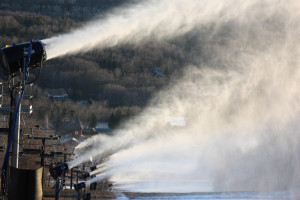
In addition to building up a base when temperatures are low enough, snowmaking is essential for damage control following unseemly weather events (rain, sleet or other forms of precipitation that aren’t snow.)
“It’s absolutely amazing what the mountain operations crews can do to create good conditions,” says Candice White, Vice President of Marketing at Sugarbush Resort.
While White agrees snowmaking is an important part of every resort’s message, she notes the primary pitch is more about delivering a good product — that is, good snow conditions on a consistent basis.
“We want to start making snow on the first weekend in November so we can open by Thanksgiving,” says White. “It’s a key component to hitting that opening day and getting us off the best possible start.” After that, it’s just piling more and more on the ground whenever possible to create good conditions throughout the typical January thaws and into the steadier snows of February and March, which is typically Vermont’s snowiest month.
Adds Michael Joseph, director of public relations at Killington: “We’re not comparing to anyone but ourselves. We guarantee a product and the investments we make are done to guarantee that product. When we start making snow, we do it to build up that base thickness so we won’t have to lose terrain.”
HISTORY LESSON
As early as the 1930s, ski jumps and ice rinks were experimenting with methods in preserving or providing a minimal coverage when natural conditions wouldn’t provide.
One of the earliest experiments was in 1934, when the Toronto Ski Club faced opening a new ski jump with no natural snow in sight. A substitute was provided in the form of shaved ice, which was hauled in tons by the truckload to cover the jump and landing.
In 1937, at the Boston Garden Ski Show, the snow was provided in the form of ground ice blown through a machine used for frosting the interiors of refrigerator freight cars. It used 100 tons of ice in about 13 hours for the first “coating.”
Later in the twentieth century, the equipment for fabricating snowy surfaces received improvements from a few unlikely places.
In the 1940s, the Canadians, British and Americans were experimenting with de-icing equipment on airplanes and needed to produce “field” conditions at the testing facilities to properly assess the effectiveness of de-icing methods. As a result, various nozzles were fabricated in an effort to generate freezing rain, fog and sleet. The output from the nozzles was described in study literature as “snow.”
In 1950, in Florida, orange growers developed a system to apply steam to prevent frosts from killing whole crops, the design for which was suggested to ski developer Walt Schoenecht as a means of snow production at his first mountain in Cornwall, Connecticut.
The first patent for snowmaking equipment (patent number 2676471) was granted in 1954 to the Tey Manufacturing Company and the first major installations of snowmaking equipment were completed in Connecticut, New York and Pennsylvania. By 1958, 18 out of 104 ski areas, including Mount Snow, were using snowmaking equipment.
Killington installed its first snowmaking system in 1963 at its Snowshed Lodge. The system was 3700 linear feet, with a 1800 foot pipe to water supply to the stream coming off Killington; water was pumped from there to the top of Snowshed, then flowed by gravity into the system.
SMALLER RESORTS
At Cochran’s Ski Area in Richmond, snowmaking is done with a small, but modern fleet of HKD and SMI guns. The area lacks a reservoir but is permitted to draw 500 gallons per minute from the Winooski River. Jesse Paul, general manager for Cochrans, says while the area has much of the same equipment as many larger areas, the quality of water drawn from the river can affect the quality of the snow. Unpredictable levels of silt in the river can be drawn and turn the snow brown. Silt can clog filters, pumps and knobs. The river can change its course, which can affect the amount of water.
“Sometimes it’s perfect,” Paul says. “Other times you don’t know what you’re going to get.”
The current pump system was installed in 2007. Before then, Mickey Cochran ran a series of small diesel compressors and drew water from the number of springs on the hill. Paul says pumping the river was an excellent improvement and gave the mountain a reliable water supply, but snowmaking still represents the most expensive cost, more than labor lifts, insurance, grooming and repair. Last year, Snowmaking and grooming ate up a third of the $400,000 budget.
“In my mind, I would never make snow in weather above 22 degrees,” Paul says. “But you’ve got to do what you got to do. And what you need is snow.”
Geoff Hatheway, marketing director at Magic Mountain, says all three factors of making snow – manpower, diesel fuel and electricity — make snowmaking one of the most expensive operations. It costs $8,000 for Magic to fill their tank to run their compressor – a supply which they can fully exhaust in one or two days of snowmaking, meaning the crew of five to six snowmakers has to be judicious about when they decide to blow snow.
“We have 1,700 feet of vertical,” says Hatheway. “And the first thing we have to do when we decide to make snow is to provide a reasonable way to get down that 1,700 feet.”
“Vermont in general does a great job of snowmaking. You can’t beat the product that gets put out there. Vermonters are also tough skiers (and those who) ski at some of these smaller places, go there for a reason.”

